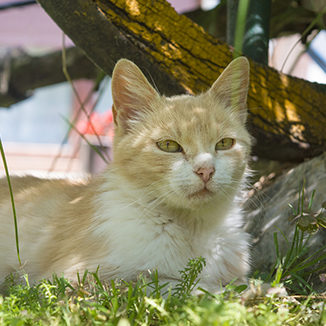If signs are pointing to an emergency, don't wait.
Call us immediately.

Pet Heat Exhaustion and
Heatstroke Awareness in Grapevine
Pet heat exhaustion and heatstroke are serious dangers that can happen all too easily. Luckily, they can also be easily prevented with awareness and a thought-out plan to keep your pet safe on even the hottest days.
Cats and dogs can sweat only minimally through their paw pads, and their fur coats also put them at a disadvantage. Pets with flat faces have shorter airways and thus have more difficulty breathing. Since panting is their main self-cooling method, these breeds will have a much harder time tolerating the heat.
How to Prevent Your Pet from Having Heatstroke
Be aware of the day’s forecast and consider your pet’s needs for that day. How are you going to keep them safe? What will you need to do if your plans suddenly change? Do you have your animal hospital’s phone number on hand just in case?
Heat exhaustion is the precursor to heatstroke, and the telltale sign is excessive panting, which shows that your pet is working hard to keep their body temperature down. If they aren’t moved to a cooler place with fresh water on hand, they could lapse into heatstroke.
Some of the most important things you can do to ensure your pet’s safety include:
- Keeping them indoors in an air conditioned space as much as possible, especially if the outside temperature exceeds 75 degrees. Accompany your pet for bathroom breaks and don’t leave them outside for more than a few minutes.
- Having fresh water nearby whenever your pet needs it. Replenish it regularly.
- Making sure your indoor/outdoor cat has a cool, shaded spot outside to retreat to that includes plenty of fresh water for them to drink.
- Taking your dog for walks very early in the morning or around sunset; hot pavement can burn your pet’s feet and increase their body temperature.
- Never leaving your pet inside of a parked car for any reason. Either bring someone else along who can stay with your pet while the car is running, or leave your pet at home where you know they’ll be safe.
- Keeping your pet’s outdoor playtime to a minimum.

Heat Stroke Symptoms
- Heavy panting
- Labored breathing
- Weakness
- Collapse
- Excessive drooling
- Decreased appetite
- Vomiting and/or diarrhea
- Unable to urinate
- Bright red gums
- Abnormally fast heart rate
If your pet is showing any signs of heatstroke, please bring them in for treatment immediately. Do not attempt to lower your pet’s body temperature by splashing cold water on them or giving them ice water—they could go into shock. For more information about heatstroke and its symptoms, call us at (817) 410-2273.
